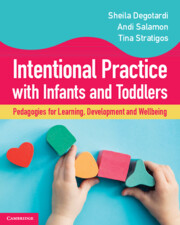Refine search
Actions for selected content:
47 results
From research to food safety and food policy: a focus on infants and young children
-
- Journal:
- Proceedings of the Nutrition Society / Volume 84 / Issue OCE2 / June 2025
- Published online by Cambridge University Press:
- 24 July 2025, E160
-
- Article
-
- You have access
- Export citation
Unfavourable food consumption is exacerbated by low socioeconomic status among children aged 1–5 years in Germany
-
- Journal:
- British Journal of Nutrition , First View
- Published online by Cambridge University Press:
- 22 July 2025, pp. 1-8
-
- Article
-
- You have access
- Open access
- HTML
- Export citation

Intentional Practice with Infants and Toddlers
- Pedagogies for Learning, Development and Wellbeing
-
- Published online:
- 17 June 2025
- Print publication:
- 12 June 2025
-
- Textbook
- Export citation
11 - Assessing, planning for and communicating learning
-
- Book:
- Intentional Practice with Infants and Toddlers
- Published online:
- 17 June 2025
- Print publication:
- 12 June 2025, pp 282-308
-
- Chapter
- Export citation
9 - Social cultures and belonging
-
- Book:
- Intentional Practice with Infants and Toddlers
- Published online:
- 17 June 2025
- Print publication:
- 12 June 2025, pp 227-254
-
- Chapter
- Export citation
3 - Pedagogy as care
-
- Book:
- Intentional Practice with Infants and Toddlers
- Published online:
- 17 June 2025
- Print publication:
- 12 June 2025, pp 64-81
-
- Chapter
- Export citation
Introduction
-
- Book:
- Intentional Practice with Infants and Toddlers
- Published online:
- 17 June 2025
- Print publication:
- 12 June 2025, pp 1-15
-
- Chapter
- Export citation
7 - Creating a language-rich environment
-
- Book:
- Intentional Practice with Infants and Toddlers
- Published online:
- 17 June 2025
- Print publication:
- 12 June 2025, pp 167-199
-
- Chapter
- Export citation
8 - Fostering knowing, thinking and theorising
-
- Book:
- Intentional Practice with Infants and Toddlers
- Published online:
- 17 June 2025
- Print publication:
- 12 June 2025, pp 200-226
-
- Chapter
- Export citation
6 - Building emotional wellbeing
-
- Book:
- Intentional Practice with Infants and Toddlers
- Published online:
- 17 June 2025
- Print publication:
- 12 June 2025, pp 136-166
-
- Chapter
- Export citation
4 - Environments for learning
-
- Book:
- Intentional Practice with Infants and Toddlers
- Published online:
- 17 June 2025
- Print publication:
- 12 June 2025, pp 82-111
-
- Chapter
- Export citation
10 - Learning in and through the arts
-
- Book:
- Intentional Practice with Infants and Toddlers
- Published online:
- 17 June 2025
- Print publication:
- 12 June 2025, pp 255-281
-
- Chapter
- Export citation
2 - Perspectives on quality
-
- Book:
- Intentional Practice with Infants and Toddlers
- Published online:
- 17 June 2025
- Print publication:
- 12 June 2025, pp 44-63
-
- Chapter
- Export citation
5 - Promoting physical health for holistic wellbeing
-
- Book:
- Intentional Practice with Infants and Toddlers
- Published online:
- 17 June 2025
- Print publication:
- 12 June 2025, pp 112-135
-
- Chapter
- Export citation
1 - Programs for infants and toddlers: The forces shaping contemporary practice
-
- Book:
- Intentional Practice with Infants and Toddlers
- Published online:
- 17 June 2025
- Print publication:
- 12 June 2025, pp 16-43
-
- Chapter
- Export citation
Maternal input, not transient elevated depression and anxiety symptoms, predicts 2-year-olds’ vocabulary development
-
- Journal:
- Journal of Child Language , First View
- Published online by Cambridge University Press:
- 12 December 2024, pp. 1-12
-
- Article
-
- You have access
- Open access
- HTML
- Export citation
Differences in gross motor and fine motor outcomes for toddlers after early complex cardiac surgery
-
- Journal:
- Cardiology in the Young / Volume 34 / Issue 8 / August 2024
- Published online by Cambridge University Press:
- 12 April 2024, pp. 1653-1661
-
- Article
-
- You have access
- Open access
- HTML
- Export citation
6 - The Origins of Prosociality from a Developmental and Comparative Perspective
- from Part I - Development of Prosociality
-
-
- Book:
- The Cambridge Handbook of Prosociality
- Published online:
- 25 May 2023
- Print publication:
- 08 June 2023, pp 108-126
-
- Chapter
- Export citation
7 - Prosocial Behavior in Infancy and Early Childhood
- from Part I - Development of Prosociality
-
-
- Book:
- The Cambridge Handbook of Prosociality
- Published online:
- 25 May 2023
- Print publication:
- 08 June 2023, pp 127-144
-
- Chapter
- Export citation
Assessing the relationship between maternal risk for attention deficit hyperactivity disorder and functional connectivity in their biological toddlers
-
- Journal:
- European Psychiatry / Volume 65 / Issue 1 / 2022
- Published online by Cambridge University Press:
- 13 October 2022, e66
-
- Article
-
- You have access
- Open access
- HTML
- Export citation
